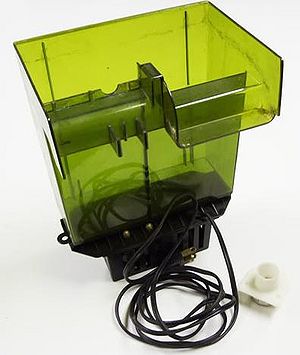History of fishkeeping
The history of fishkeeping as we know it dates from the Victorian era. As British naturalists were exploring the world's exotic locations and sending back drawings and living and dead specimens of strange and wonderful aquatic creatures and plants, just as with tropical plants, people wanted to find a way to keep them in their homes.
1950s
The post-war era saw a revolution in various hardware available to enhance the fishkeeping hobby, due to the invention of plastics, and also to the readily available cheap labor source in Japan.
Largely, this meant that inexpensive in-tank air-driven box filters could be mass-marketed, as could the more expensive air-driven or even motor-driven HOB type filters. The HOB filters of the day were fed by multiple siphons, with the cleaned water returned to the tank via air or motor driven pumps.
Also, silicone glue to assemble tanks began to herald the future: the "all glass" tank.
1970s
By this time, advances in available technology and understanding of aquarium biochemistry were slowly changing and advancing the picture.
While the US manufacturers were still "hooked" on siphon-fed, noisy, unreliable HOB filters, European manufacturers were beginning to develop under-tank canister filters.
1980s
By now the nitrogen cycle was relatively well understood. Companies like Eheim, Fluval, et al. were producing high quality canisters in many sizes in Europe, with some being imported to the US. In the US, Hang On Back (HOB) filters were becoming more and more popular. The most prominient of these at the time was the Dynaflo 150, released in 1981. It utilized a magnetically-driven impeller which was run by an externally separate motor. These filters could be run as a "full flow" filter using two plastic plates to hold the media, or as a "disposable cartridge" filter.
MarineLand entered the US market around this time with their AF-1 and AF-2 filters, which were upclass parallels to the Dynaflo 150 in the first case, and a double-size unit in the latter. They were quieter and more subtle, in the European tradition.
Heaters in the US were still clamp-on devices that were prone to breakage. The more sought-after models were made in Europe, and were submersible, elegantly colored, and attached with suction cups.
This era also saw the development of more specialized types of aquarium - the Dutch "planted tank" which focused more on the plants than the fish grew in favor, and required more technology and chemistry to support, and the marine "reef tank" started to gain in popularity, partially due to the development of the external "wet/dry" massive biological filter systems.
The hobby was booming.
1990s
Much hardware was improved, with gradual sophistication slowly moving through all products available, although clunky in-tank air-driven filters were never killed off.
The hobby went into a slow decline as the internet took over as the "fun thing to watch in your spare time".
2000s
By now the large specialist pet stores that devoted 50% of their square footage to fish were closing. The "angel crash" of the late 80s never really ended. Tanks still sell at manufacturing cost all the way through the supply chain.
